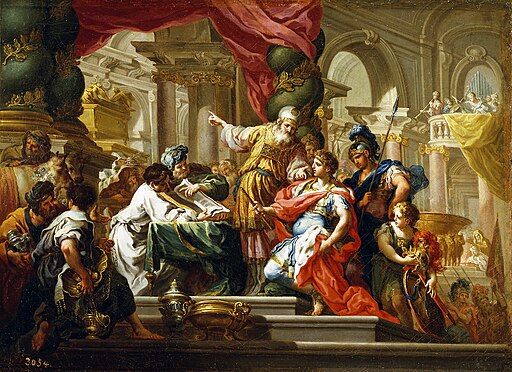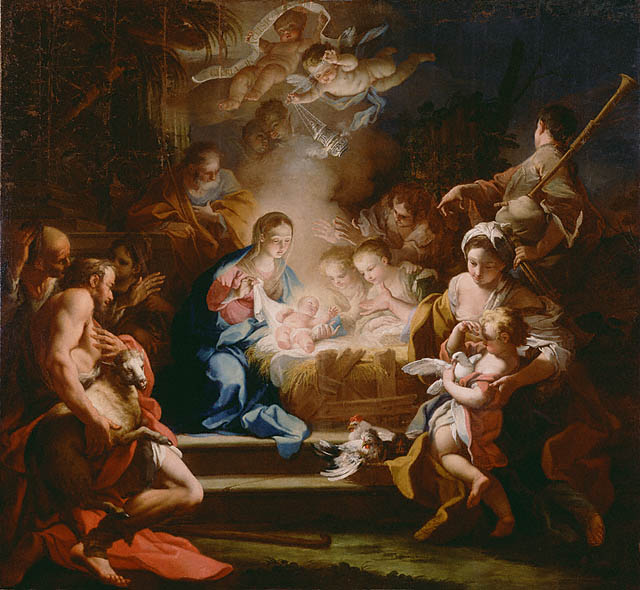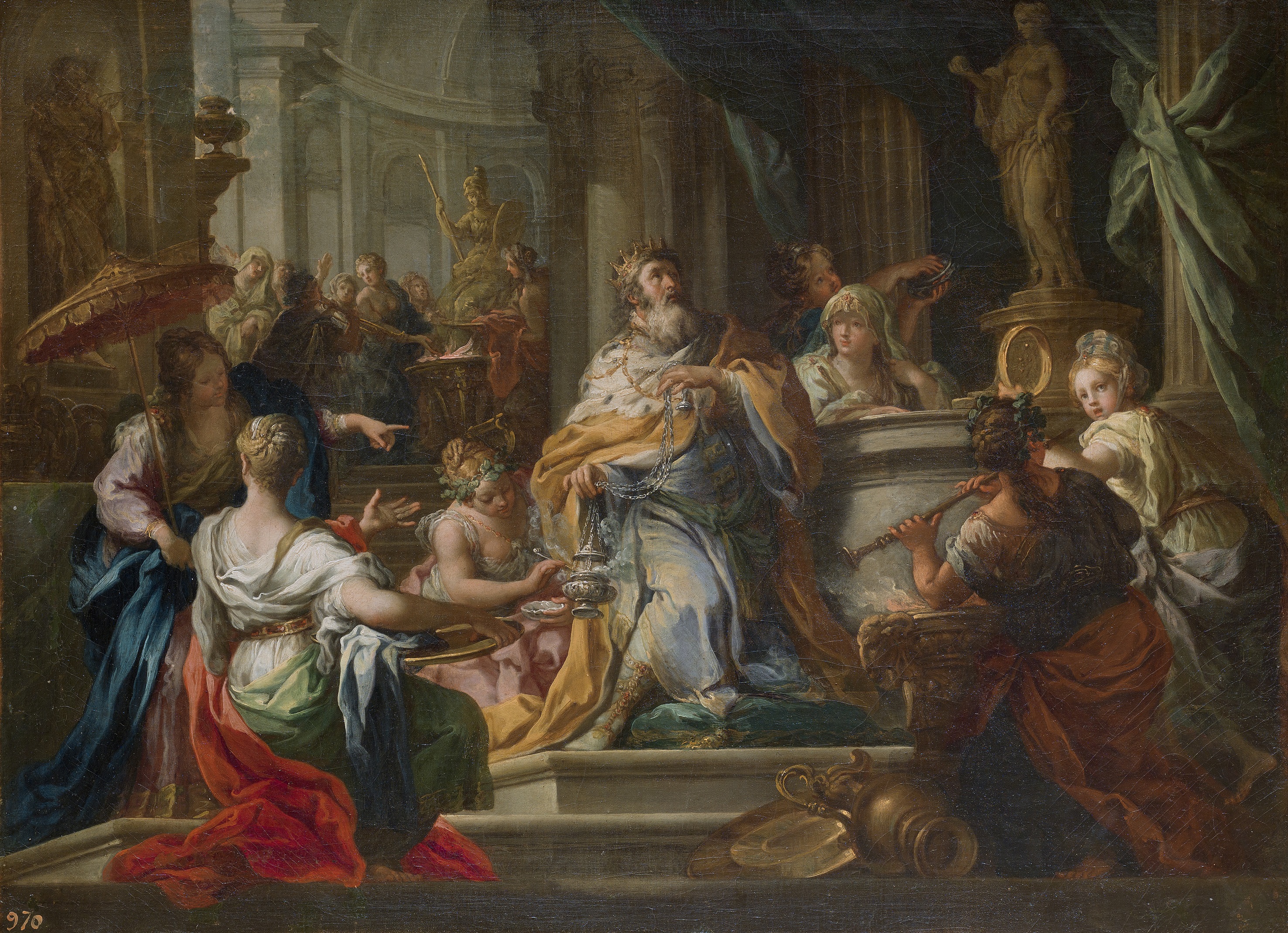
Christ in the Garden of Gethsemane, 1746
Born in the small town of Gaeta near Naples on January 8, 1680, Sebastiano Conca was a late Baroque Italian artist. Conca has a style that is more Mannerist than Baroque, and considering he painted well into the Rococo period he nonetheless maintains his Manneristic-Baroque method only with more color, showing a clear Venetian influence in his work. Interestingly, during this period Naples was flourishing as a city producing its own Baroque Masters, including Francesco Solimena who taught Conca. Later Conca himself opened his own school, the Accademia del Nudo which attracted a large following from artists all over Italy and Europe, one of the most famous being Pompeo Batoni, whose birthday is also later this month. This would lead to Conca teaching at the famous Accademia di San Luca in Rome for two separate terms, although his name today is not well known as his work was eclipsed by others. Nonetheless Conca is interesting for his compositions, figure arrangements and his deep color harmonies, especially his use of yellows.
Note in Christ in the Garden of Gethsemanethe angels hover above Christ in a circular arrangement with warm yellows, and the eldest angel, with chalice in hand, in a cool blue and warm yellow drapery. Christ below them is in a kind of box-like composition, with vivid blue drapery to contrast with the cool of the angel, and his red is tinted down. Conca's brushwork on the rock conveys the hard texture, and he reflects the warm light from the angels on the ground near him. Despite the many variations on this very theme over the centuries, it is Conca's interpretation that is among the most interesting and well-done.

Alexander the Great in the Temple of Jerusalem, ca.1750
This is a beautiful painting. Conca is firing on all cylinders here, in every sense artistically. By raising the main figures on a stepped platform, their importance is instantly noticed, which contrasts to the distant figures in the background. Conca uses a dynamic figure placement, in such a way as that they all fit inside a pyramid, an unusually clever idea. The use of green is particularly interesting also, contrasting with complementary red and harmonizing with white and yellows. Note the massive green Solomonic columns behind them draped in red, and beyond Conca creates a huge scale of atmospheric perspective and dramatic light to showcase the glory and splendor of this once great temple. Faces are not Conca's forte...they seem to have a cartoony look to them at times, yet he more than compensates for this with incredible atmosphere and architecture to create mood. Curiously, this theme of Alexander in the ancient temple appears to have been only painted by Conca. Even more curious is despite the legendary reputation of Alexander there exists relatively few paintings of him from the Renaissance through the Baroque, not until David painted him not much later in the late eighteenth century. Conca gives it a grandeur that it deserves.

Adoration of the Shepherds, 1720
Conca's Nativity glows with a warm red in a scene that looks more like a theatrical play than a religious painting. This theme has been painted by countless artists, in countless styles that include tenebrism, isolation, and heavy piety yet here Conca showcases a party-like atmosphere instead of drama. Once again Conca raises Mary and Jesus on a two-step platform which leads our eye directly to them, and baby Jesus is nearly at the center of the painting, just below it actually. Look at the cherub floating above waving a thurible of incense with someone below him trying to grasp the fumes with his bare hands, and the bagpiper pointing at newborn Jesus. A woman, probably St. Anne, indicates the nativity to a young boy, who is squinting hard at the bright lights while holding a dove in his hands. Across from them is a muscular shepherd with sheep in one arm and staff on the ground, and he appears to be awed more by the hens in the basket than the actual nativity. The painting is full of triangles. Despite its unwitting humour, the painting is superbly painted, in all aspects, and flaunts Conca's synthesis of Renaissance, Mannerism and Venetian color all in one work.

Miracle of Saint Turibius, Archbishop of Lima 1726
Canonized the same year this painting was finished, Saint Turibius was a highly educated Spanish missionary who did extensive work in Lima, Peru where he was eventually made Archbishop. Conca depicts him here at one of his many sermons, parting the seas in true Moses-like fashion in front of a rather large audience at the beach. Conca's color work and dramatic light is what makes the painting. I can't honestly think of any artist who used yellows as effectively as Conca did. The way he places it next to blue in particular, in the African figure on the right and mimicked at the sunset behind them, while using yellow to depict the followers of Turibius with him in blue. His tight, foreshortened faces seem to overlap in perspective behind the missionary holding the cross. Conca takes an unusual scene and makes it palatable for the viewer without too much melodrama.

Idolatry of Solomon
Conca's raised platform again, this time leading the eye off to the right. A very warm painting with deep yellows, Conca demonstrates his forte at interiors with amazing architecture and riveting chiaroscuro. Solomon's wives are all arranged on a diagonal, and note how Conca creates visual interest by alternating direction of the women by facing the viewer, then back turned to viewer, with all arms and hands pointing to the King himself. Conca here also alternates visual contrast itself by the vivid colors on the women to the left with deep but transparent shadows on the right figures. Swathed in yellow and blue with white, Conca creates a very believable King Solomon. Conca's faces once again sometimes portray that cartoony innocence that is annoying when you look closely, yet when you look overall at this brilliant composition and stunning color, Conca's gifts shine through. Note the figures in the background and how they appear to be lit by candlelight,as the dome above them reflects an atmospheric, greenish hue that contrasts with the warm browns of the foreground. Conca's work is like a kind of music, beautiful and satisfying as it should be.
Comments
Post a Comment